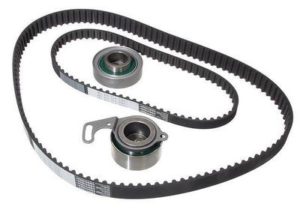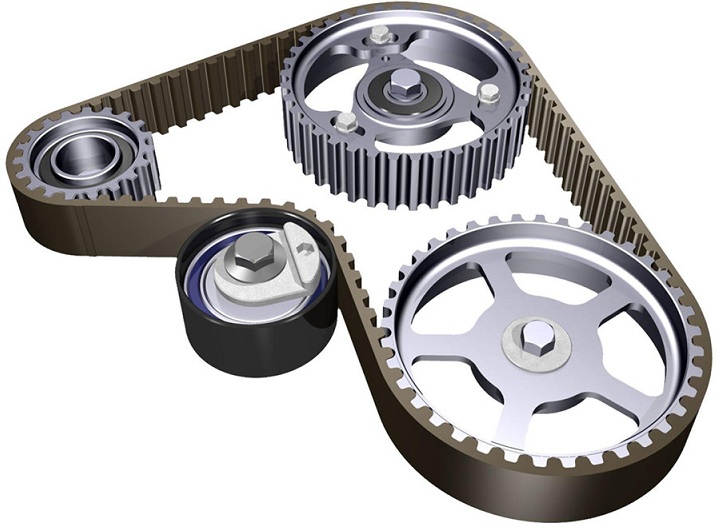Belt Replacement Guide
Difficulty: Moderately difficult
Duration: May take several hours
How often: Every 60,000–100,000 miles, check owner’s manual
One out of every five vehicles on the road needs a new belt. We Southern know how guide helps you through the steps necessary for proper diagnosis.
The introduction of the Ethylene Propylene Diene Monomer (EPDM) belts in the late 1990’s have made wear detection harder than when the Neoprene belts were used. Still, there are indicators to look for that signal it’s time for a new belt.

Step 1
Perform preventative maintenance.
One way to make sure your belts are up to par is to schedule a belt replacement during a routine checkup. If a belt has 65,000 to 70,000 miles on it and your vehicle is already in the shop, go ahead and replace the belts. The technician should also check the condition of the automatic belt tensioner to ensure that the new belt is properly tensioned.
Step 2
Look for visual signs.
Some of the visual signs that indicate it’s time for belt replacement are abrasion/misalignment, cracking, glazing or pilling.
Abrasion/misalignment: The nylon on your belt is essential. If there are any tears, they may cause misalignment and your belt won’t work properly. If the belt is misaligned and slipping, you will hear unusual noise or feel vibrations.
Cracking: With Neoprene belts, it was common to look for three cracks in three inches, as a rule that the belt’s life was over and it needed to be replaced.
The new EPDM belts are built to resist cracking, making it harder to notice wear at first glance. With EPDM belts, look for rubber loss that’s similar to how a tire wears out over time. The loss of just 5% of the belt material can cause the ribs of the belt to “bottom out” on the pulley(s). This accelerates belt wear and causes it to slip, which may affect the water pump, alternator or air conditioning compressor performance.
Glazing: The belt is hard at work bending and flexing against a pulley, producing heat that causes its rubber to harden over time. If the belt gets loose, the added friction makes it hotter. This causes glazing and makes the belt slip more.
Pilling: As your belt ages, it loses material that can build up in the belt grooves. This can contribute to a lack of tension, misalignment and worn pulleys.
Step 3
Make smart repair decisions.
If your vehicle is in the shop for another repair such as a water pump, alternator, or other belt drive accessory component, be sure to have the belt replaced. Depending on the vehicle, you can often save money, as the labor for belt replacement may be included in the labor for accessory.
Step 4
Know that two major causes of belt failure are improper tension and misalignment.
Vehicles using a single serpentine belt often use an automatic belt tensioning system. This system is designed to apply a constant force on a belt. The tensioner compensates for belt length changes due to wear or load changes within the system.
The tensioner and associated pulleys should always be checked for wear when changing the belt. Tensioners normally fail at the same rate as belts fail.
Replacing your belts
If you would like to replace your car belt or belts yourself, follow these steps:
1. Mark the rotation direction on the belt.
2. Unload the belt from the tensioner by rotating the tensioner.
3. Remove the old tensioner from the engine (if the tensioner is being replaced).
4. Install the new tensioner.
5. Torque the mounting bolts to 1/3 installation torque in a star pattern.
6. Retighten the bolts to 2/3 torque, then to full torque.
7. Install the belt in the same direction as the old belt.
8. Load the belt on the tensioner by rotating the tensioner as indicated (see rotate to load pointer).
9. Tighten the belt until the pointer falls between the two marks.
10. The gauge window, showing the maximum and minimum marks, is located on an area between the base and arm of the tensioner assembly.
Important Tips:
- The performance of your accessories is directly affected by the condition of your belts. Just a 5% loss of material can affect component performance.
- Never use belt dressing or any type of substance to coat the belt. Contamination from applying a substance on the belt will adversely affect belt life.
- There are no serviceable parts inside a tensioner. The entire assembly must be replaced.
- When re-installing a belt, clean the pulley groves. Dirt or paint on the pulleys may cause belt noise.
- A belt failure affects the driveability of the vehicle, leaving the passengers stranded until a new belt is installed.
